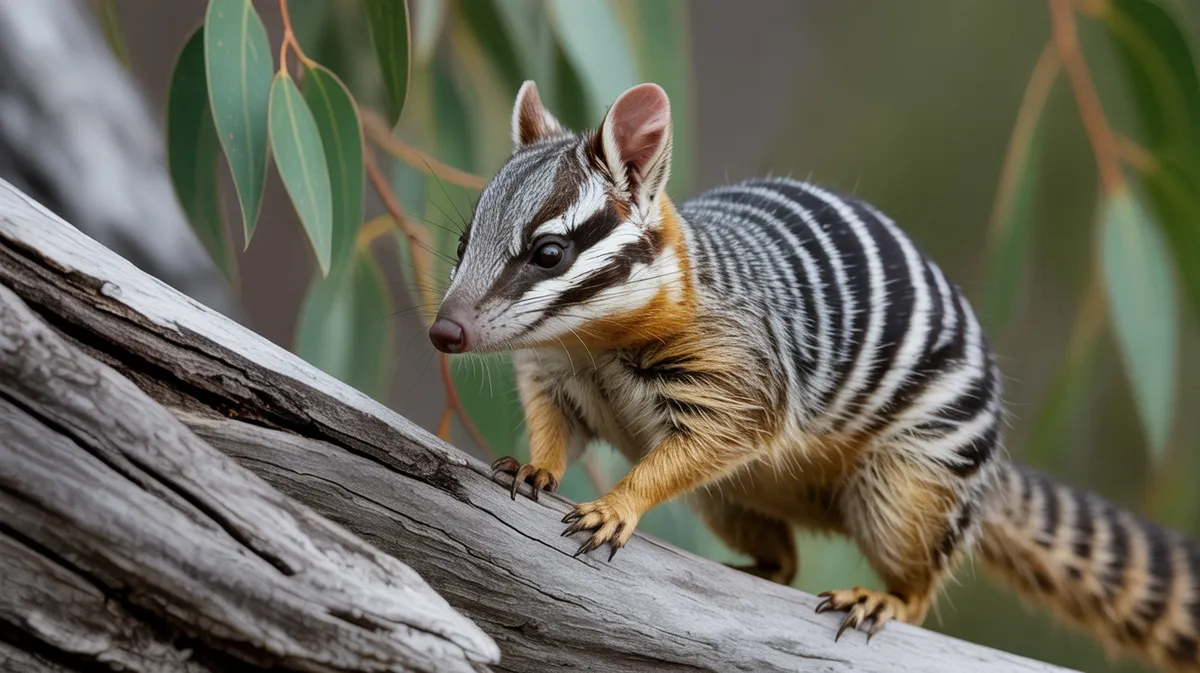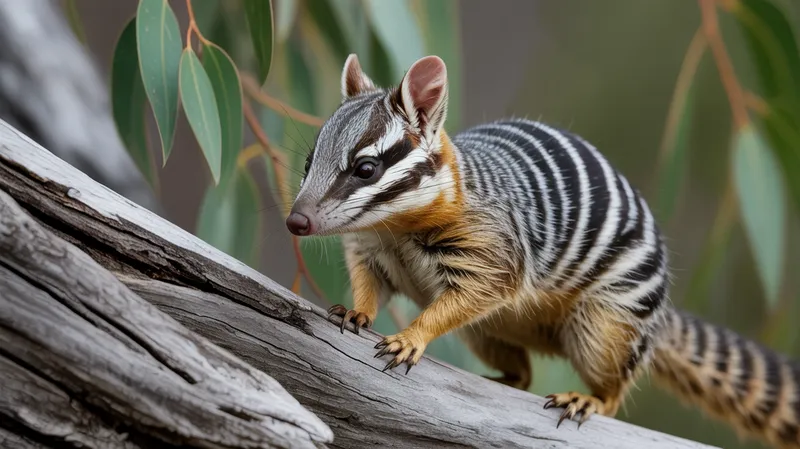
Numbat
Myrmecobius fasciatus

Meet the Numbat
The numbat is a small, diurnal marsupial native to Western Australia, easily recognized by its reddish-brown fur and distinctive white stripes across its back. Unlike most marsupials, numbats are specialized termite eaters, using their long, sticky tongues to extract termites from narrow crevices and logs. They are largely solitary and spend their days foraging in woodlands, relying on their keen sense of smell to find termite colonies. The numbat is unique among marsupials for being active during the day and lacking a true pouch for its young.
Classification
Mammal
Habitat
Eucalypt woodlands
Diet
Insectivore
Lifespan
5-6 years
Conservation
Endangered
Weight
280-700 grams
📖Fascinating Facts
Termite Specialist
Numbats feed almost exclusively on termites, using their elongated, sticky tongue to extract them from logs and soil.
Daytime Forager
Unlike most marsupials, numbats are active only during the day, which helps them avoid nocturnal predators.
Marsupial Without a Pouch
Female numbats lack a pouch, so their young cling directly to the mother’s belly fur until they are large enough to be left in a nest.
📋Detailed Description
The numbat (Myrmecobius fasciatus) is a small, slender marsupial measuring 20–27 cm in head-body length, with a bushy tail adding another 13–17 cm. Adults typically weigh between 350 and 700 grams. Its pelage is reddish-brown to grey, marked by 4–7 prominent white stripes across the rump and lower back, providing camouflage among dappled woodland light. The numbat has a pointed snout, large dark eyes, and a long, slender tongue (up to 11 cm) adapted for termite extraction. Unlike most marsupials, it lacks a true pouch; instead, females have four teats and carry their young attached to the abdomen. Numbats are strictly diurnal, with peak activity in the late morning and afternoon, and are solitary outside of the breeding season. Their dentition is reduced, reflecting their specialized insectivorous diet, with weak jaws and numerous small, peg-like teeth. The species is highly territorial, with individuals maintaining exclusive home ranges of 25–50 hectares. Numbats are agile climbers and diggers, using strong forelimbs to access termite galleries in logs and soil. Their lifespan in the wild is estimated at 4–6 years, though captive individuals may live slightly longer.
💡 Did you know?
Numbats are the only member of the family Myrmecobiidae, making them evolutionarily unique among marsupials.
🔬Research & Sources
Wikipedia Summary
The numbat, also known as the noombat or walpurti, is an insectivorous marsupial. It is diurnal and its diet consists almost exclusively of termites.
Last Modified: 6/3/2025
🎭Behavior & Social Structure
Numbats are unique among Australian marsupials for their strictly diurnal activity, likely an adaptation to termite foraging patterns and predator avoidance. They spend most of the day actively searching for termites, using their acute sense of smell to locate underground galleries. Foraging involves rapid, methodical movement across the forest floor, pausing to sniff and dig shallow holes with their claws. Once termites are detected, the numbat inserts its long, sticky tongue to collect them—consuming up to 20,000 termites daily. Numbats are solitary and highly territorial, with minimal overlap between individual home ranges. Social interactions are rare outside the breeding season and are typically limited to brief encounters or aggressive displays. At night, numbats shelter in hollow logs, burrows, or tree hollows, which they line with plant material for insulation. They are vigilant and rely on keen senses to detect predators such as birds of prey, foxes, and feral cats.
👶Reproduction & Life Cycle
The numbat's breeding season occurs from late December to early January. Males compete for access to females, and after mating, the female gives birth to up to four tiny, altricial young after a gestation period of approximately 14 days. The young attach themselves to the mother's teats, remaining there for about 6 months, protected by a patch of sticky skin and fur on the mother's abdomen. As they grow, the young are left in a nest within a hollow log or burrow while the mother forages. Weaning occurs at around 8–9 months, after which juveniles become independent but remain within the maternal range for several weeks before dispersing. Sexual maturity is reached at around 12 months. Reproductive success is closely tied to termite abundance and habitat quality.
🛡️Adaptations & Survival
Numbats exhibit several remarkable adaptations for their specialized termite diet. Their elongated, sticky tongue is perfectly suited for probing narrow termite galleries, while their reduced, peg-like teeth and weak jaws reflect a diet that requires little chewing. Their keen sense of smell allows them to detect subterranean termite colonies. Diurnal activity aligns with the periods when termites are closest to the surface. The numbat's cryptic coloration and striping provide camouflage from predators in the woodland understory. Strong forelimbs and curved claws facilitate digging and climbing. The absence of a pouch is unusual among marsupials, possibly reflecting the reduced need for protection due to their relatively safe, insulated nesting sites.
📚Research Sources
🎨Cultural Significance
The numbat holds cultural significance for several Indigenous Australian groups, who know it by names such as 'walpurti.' It features in Aboriginal mythology and Dreamtime stories, often symbolizing resourcefulness and adaptation. The numbat is the official mammal emblem of Western Australia, reflecting its unique status and conservation importance. There are no known traditional uses of numbats as food or medicine, likely due to their rarity and specialized habitat.
🔬Recent Research & Discoveries
Recent research has focused on numbat genetics to inform conservation management and maintain genetic diversity in captive and reintroduced populations. Studies using GPS tracking and camera traps have provided new insights into home range size, habitat use, and predator interactions. Ongoing research is investigating the impact of fire management and predator-proof fencing on population recovery. Advances in reproductive biology, including artificial rearing and assisted breeding, are being explored to support population supplementation. The numbat is also a model species for studying marsupial evolution, as it is the only surviving member of the family Myrmecobiidae.
🎥Wildlife Videos

Numbats
Filmed for over a year, the definitive film on the life cycle of a family of the rare and endangered marsupial Numbat - one of the ...
WildfilmAustralia

The Numbat
This is a video of the numbat taken from the BBC's Life of Mammals.
globalzoo

Experiencing The RARE NUMBAT Mammal | Full Episode | Wildlife of Tim Faulkner
-- Stay up to date with all things Bondi Vet at: https://bondivet.com/ Facebook - http://tinyurl.com/FacebookBondivet Instagram ...
Bondi Vet

Numbats | Amazing Facts about Kangaroos' Unknown Cousins
The numbat is highly endangered, with only 1000 left in the wild. Human settlement and the introduction of predators like foxes ...
Terra Mater

🐜 The Termite-Eating Specialist! | Amazing Numbat Facts You’ve Never Heard
Meet the Numbat – one of Australia's most unique and endangered marsupials! In this in-depth video, we take a deep dive ...
Ases World

Numbat - The Colorful Ant Eating Marsupia
In this episode of Wild Wisdom, we take a closer look at the Numbat, Australia's colorful ant-eating marsupial. With its striking ...
WildWisdom
🌍Habitat Information
The Numbat typically inhabits Eucalypt woodlands environments. Numbats have adapted to their environments with specialized features and behaviors.
Primary Habitat:
Eucalypt woodlands
More detailed habitat information will be available soon.
🛡️Conservation Status
The Numbat is currently classified as Endangered. Conservation efforts are crucial for preserving this species for future generations.
Common Threats:
- 🏠Habitat loss and fragmentation
- 🌡️Climate change impacts
- 🎯Hunting and poaching
- 🏭Human-wildlife conflict
⚠️Threats & Conservation Challenges
The numbat faces numerous threats, primarily habitat loss and fragmentation due to land clearing for agriculture and urban development. Predation by introduced species, particularly the European red fox (Vulpes vulpes) and feral cats (Felis catus), has been a major driver of population declines. Fire regimes that reduce hollow log availability and alter termite populations further threaten their survival. The species is now restricted to a few small, isolated populations in southwestern Western Australia, with some reintroduced populations in fenced reserves. The total wild population is estimated at fewer than 1,000 individuals. Conservation challenges include maintaining genetic diversity, controlling introduced predators, and restoring suitable habitat.
🔬Scientific Classification
Scientific Name
Myrmecobius fasciatus
Classification Hierarchy
🔍 About Taxonomic Classification
Taxonomic classification is a hierarchical system used by scientists to classify and organize living organisms based on shared characteristics and evolutionary relationships.
The system moves from broad categories (Kingdom) to increasingly specific ones, with each animal's scientific name typically consisting of its Genus and species.
📝Community Notes
Share your observations and insights about the Numbat with our community of wildlife enthusiasts.
Join Our Community
Sign in to share your observations and connect with fellow wildlife enthusiasts.
Sign In to ContributeNo community notes yet
Be the first to share your observations about the Numbat!
Explore Numbat
Select a tab above to learn more about this amazing animal.
📸Photo Gallery
No photos available for this animal yet.
🌟Discover More Wildlife
Continue your journey of discovery with more fascinating animals from our database
